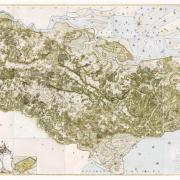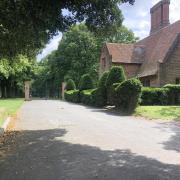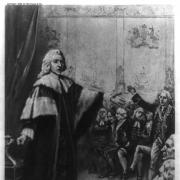We’ve got our fair share of hauntings here in the county: from echoing screams in a gloomy wood to the padding spectre of a doleful hound; from the bitter chill of a lover’s anguish to the gossamer sails of a phantom ship, it seems the dead do not go quietly. If you are looking for a ghostly tale to tell by the light of a pumpkin lantern, there are a few local legends that might send shivers down the spine of even the hardiest sceptic...

At Hallowe’en, they say, the dead walk among us and at this time of year, when the veil between the realms is at its thinnest, you would do well to keep your wits about you when venturing out into Kent's shadows. The Wealden village of Pluckley, boasting more than a dozen resident spooks, is known as the most haunted village in Britain. Plangent cries of lost souls are heard in the depths of the ‘Screaming Woods’ (Dering Woods) on the village’s outskirts; flickering lights are seen at night, flitting between the windows of the locked and empty parish church of St Nicholas; a wraith-like, grieving mother scours the churchyard for the grave of her lost child, but perhaps Pluckley’s most famous ghost is that of the 18th-century highwayman, often sighted at ‘Fright’ (or Frith) Corner.
For months, he terrorised the road into and out of the village, lying in wait under the cover of the ancient trees. Some say he was challenged by a traveller who refused to give up his purse, others that he was ambushed by locals or members of a rival gang; whoever was responsible, it seems the highwayman met a grisly end, pinned by a sword, driven through his heart, to the oak tree in which he had been hiding.
![Great British Life: Leeds Castle [out of copyright vintage postcard] Great British Life: Leeds Castle [out of copyright vintage postcard]](/resources/images/17267921.jpg?type=mds-article-575)
A pair of spectral black dogs have often been glimpsed roaming the grounds and prowling the dark corners of Leeds Castle. Their presence is usually announced by the soft sound of paws on the wooden floors or the muted rumble of a gentle growl. Many believe the dogs to have been conjured by the witchcraft of Eleanor Cobham, Duchess of Gloucester, during her imprisonment at Leeds in 1441. Abandoned by their mistress after her removal, the dogs are doomed to search for her indefinitely, and some say that death follows in their wake.
Others believe the dogs to be the castle’s guardians, such as the guest who encountered one of the heroic hounds in the area known as Henry VIII’s Banqueting Hall. Gazing out from a window seat, she was distracted by the sudden appearance of large, black dog in the room behind her and jumped up to follow as it left. As she did so, a section of the bay in which she had been seated fell away and plummeted into the moat. Had she still been sitting there, the woman would have fallen to her death. Instead, she had pursued the dog, away from danger and into another room - only to watch it disappear through the solid stone wall …
![Great British Life: A vintage postcard of Ightham Mote [out of copyright] Great British Life: A vintage postcard of Ightham Mote [out of copyright]](/resources/images/17267922.jpg?type=mds-article-575)
A centuries-old tragedy came to light in the 1870s at another of Kent’s celebrated stately homes. Men working in a room on the upper floor of Ightham Mote uncovered a hidden doorway. A service staircase, perhaps? Or a hidden cache of jewels? With bated breath, they carefully prised away the boards, but no treasure awaited them. There, in the cobwebbed gloom, sat the upright skeleton of a woman - all features lost to the passing centuries, but dressed in a greying gown of the 1500s. This gruesome discovery gave credence to the local legend of an ill-fated love affair between a ladies’ maid and the priest retained to say private mass for the family in their hidden chapel.
Devastated by the shame of their discovery, the priest took his own life, but his lover was subject to the wrath of her employer, who incarcerated the woman and left her to perish in the dark. The apparition of a ‘grey lady’ at Ightham is often reported, restlessly gliding from room to room, searching across the moat for her long-lost love. In one of the bedrooms, visitors experience a sudden and inexplicable drop in temperature - a lasting manifestation of the grey lady’s bitterness and despair.
![Great British Life: A vintage postcard of Scotney Castle (out of copyright] Great British Life: A vintage postcard of Scotney Castle (out of copyright]](/resources/images/17267923.jpg?type=mds-article-575)
The view from the bastion at Scotney Castle encompasses a wide vista as the garden tumbles down towards the picturesque feature of what is not (as many believe) a folly, but the genuine ruin of the mediaeval castle that dominated the estate until the 1830s. One 18th-century custodian, Arthur Darell, was held in poor regard by most who knew him: a drunkard, a wastrel and a smuggler, he was deemed an unfit heir.
In the early 1700s, Darell found himself on the run from the Customs men: crouched inside the old castle’s entrance, he shuddered with every heavy thud as the Customs officer hammered against the oak door. In desperation, he burst out and grappled with the officer, eventually wrestling him to the ground and dashing his head against the stones. Realising what he had done, Darell dragged the officer’s lifeless body across to the moat and watched as it sank into the dark, still water. Perhaps Darell thought he’d got away with it, but the Customs man was not so easily defeated: to this day, a heavy fist can be heard pounding the castle door and the dull, steady rhythm of trudging footsteps is heard echoing around the empty ruin, when not a soul is to be seen…
![Great British Life: Stron on the Goodwin Sands (out of copyright vintage newspaper illustration] Great British Life: Stron on the Goodwin Sands (out of copyright vintage newspaper illustration]](/resources/images/17267924.jpg?type=mds-article-575)
In February 1748, Captain Reed weighed up the risk of the impending storm. The crew of his schooner, the "Lady Lovibond" was experienced and, if necessary, they could always take shelter in the safe anchorage of The Downs, a sheltered area of sea between the north and south Foreland, rather than attempt to navigate the treacherous "ship swallowers", the Goodwin Sands. Besides, Reed was celebrating his recent marriage with a good feast and extra measures of rum all round. But his First Mate, John Rivers, had other ideas and was seeking revenge for having been rejected by the new Mrs Reed.
Deliberately steering the boat off course and into danger, Rivers quickly achieved his aim of wrecking it and people on shore watched in horror as its hull splintered and its masts broke away. Fifty years later, James Westlake was sailing the "Edenbridge" towards Deal. It was foggy and dark, and somewhere, out of the miasma, came the sound of a fiddler and a happy crowd. He saw nothing until an outmoded three-mast schooner was suddenly on top of him. A fishing boat nearby witnessed Westlake’s encounter as the schooner floundered and finally succumbed to the waves. Fifty years later still, on the anniversary of the wreck, an unusually antiquated ship was seen to be struggling off Walmer and Deal. The lifeboat crews scoured the Goodwins, but not a soul was ever recovered, and no ship was ever found. The last reported sighting of the phantom "Lady Lovibond" was in 1948: as an antiquated three-mast schooner pulled alongside Captain Bull Prestwick’s boat, heading directly out towards the Goodwins, he heard the sounds of much merrymaking and the melodic refrain of a violin.
So, if you decide to go out and about in Kent this Hallowe’en, the likelihood is, you won’t be as much alone as you might think you are...


















![The torchlit Wassail procession makes its way to the New Ash Green Community orchard [Photo courtesy of New Ash Green Woodlands Group]](/resources/images/128x89/1x/17558355.jpg)
![The torchlit Wassail procession makes its way to the New Ash Green Community orchard [Photo courtesy of New Ash Green Woodlands Group]](/resources/images/180x180/1x/17558355.jpg)








